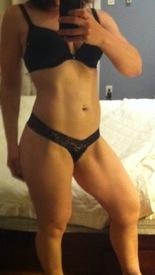We are pleased to announce that on March 4, 2025, an updated Rich Text Editor will be introduced in the MyFitnessPal Community. To learn more about the upcoming changes, please click here. We look forward to sharing this new feature with you!
Body fat calipers

douglasmobbs
Posts: 563 Member
I am trying to work out what a good target body weight would be, and have come to the conclusion that the best would be based on my lean body mass.
With currently being obese there is a lot of me to fit into the calipers, so I am wondering which ones would be best for the larger person.
Also, suggestions of good web sites and guides on where and how to measure together with charts would be appreciated.
With currently being obese there is a lot of me to fit into the calipers, so I am wondering which ones would be best for the larger person.
Also, suggestions of good web sites and guides on where and how to measure together with charts would be appreciated.
0
Replies
-
I have no experience with manual calipers, which I've read require some skill. You might want to consider a scale that provides a body fat percentage estimate. Tanita and Withings are brands that have that feature. I've also seen web sites with formulae for estimating your fat percentage based on various measurements, including your wrist. I would Google them. The result I got was 3 points higher than that on my Tanita scale.0
-
I have looked at the calculations on
http://www.fat2fitradio.com/tools/mbf/
My problem with this calculation is it takes no account of leg size. My bottom half has always been stronger than my top half so I think that the calculations based on neck, waist and hips will be a bit out for me.0 -
Normal measurement areas are:
Front of bicep
back of tricep
side of your waist
upper right side of your back
great link here..
http://www.muscleandstrength.com/tools/how-to-measure-bodyfat-using-calipers.html
Hope this helps0 -
I have looked at the calculations on
http://www.fat2fitradio.com/tools/mbf/
My problem with this calculation is it takes no account of leg size. My bottom half has always been stronger than my top half so I think that the calculations based on neck, waist and hips will be a bit out for me.
Oh, I see. I forgot to mention that I once knew someone with an Omicron hand-held device with sensors that several years ago was about $30. It was pretty accurate.
Good luck! I think keeping track of body fat percentage is more important than weight.0 -
The much more accurate method of measuring body fat, and the one I highly recommend, is using body fat calipers. You can get fancy ones or cheap ones. They all work well! You can find them from about $10 on Amazon.com (like the ones pictured on the left). Once you get a set of calipers, then all you need is a way to plug in your measurements to a calculation method to see where your body fat percentage falls.
I like to use the software by www.linearsoftware.com. Click HERE to access their body fat calculator page. There are separate calculation methods for men and women, and there are multiple methods to use. You can experiment with them to determine which one you find most predictable and repeatable. It’s a good idea the first time to measure your body fat with multiple methods to be sure you are doing it correctly.
Once you get used to the caliper method, you can be sure that your changes in body fat are very accurate. While operator error may lead to a slight variation in the body fat reading, any changes will be very precise (as long as you measure the same way each time). For instance, if you measure 10% body fat, you can assume that you are anywhere from 9% to 11% depending on operator error. But if the next time you measure, you measure 9.5%, you know for certain that you lost .5% body fat (even though you still could be in a range from 8.5% to 10.5% of actual body fat depending on operator error).
I prefer the Jackson/Pollack 3 site method because it’s quick, easy, and accurate. It requires measuring sites on the chest, the abdomen, and the thigh. It’s easy to do by yourself. I recommend doing any body fat measurements first thing in the morning when you wake up, before you’ve eaten, had anything to drink, or exercised. That’s the most reliable way to get consistent measurements (the least amount of variables are at play).
So many times we get frustrated if the scale isn’t moving down, but what we all should care about more is what is happening with our body fat percentage. Building muscle is a good thing, and it makes us more fit, more healthy, and able to burn more calories all day long. Often people burn up their precious muscle mass in an effort to crash diet and lose weight. This sets them up for failure because they have less muscle mass to burn calories and when they fall off the wagon, they gain back all the weight and then some.
Do yourself a favor and stop weighing yourself all the time! Instead, get some calipers, get comfortable with a measurement method, and check your body fat every week or 2 weeks. Write it down so you can monitor your progress.0 -
Calipers are really tricky to get an accruate reading ( I do not use them personally so I cannot help with how best to use them - sorry). The best methods are Hydrostatic (dunking in water) and DEXA but you have to go to a facility to get them done and they cost money - about $70 for the DEXA one and I think about $40 for the Hydrostatic. You may want to look into seeing if you can have it covered on your insurance (I have no idea if it would be, but its worth asking). I am not sure about the DEXA one but the Hydrostatic test I did gave me an analysis that indicated my ideal body fat %, how much I should eat to reach my goal and a bunch of other stuff.
Anyway, for an indication of what you should be aiming for see: http://www.livestrong.com/article/165294-recommended-body-fat-percentage/0 -
calipers only measure subcutaneous fat and are very easy to screw up the measurements(making them very inacurrate to get reliable info). Here is a list of 10 things you may need to know if you want to go by them. This is just for your info as I dont actually believe you can get accurate bodyfat % from calipers, but this has some good points.
The Top 10 Tips When Using Body Fat Calipers
"1. Use body fat calipers to measure progress only. Don't compare body fat percentage to tables or norms. Even experts using the best body fat calipers can't be totally accurate.
2. For greater accuracy, monitor changes with skinfold measurements rather than converting them into a body fat percentage and using that to judge progress.
3. Have an experienced examiner test you if possible. At the very least have the same person test you each time. If you are a Health and Fitness professional be meticulous about how you find skinfold sites.
4. If you want to test yourself the only viable option at the moment are Accu-measure body fat calipers. Do not, I repeat do not splash out on quality calipers if you only intend to test yourself.
5. If you test other people buy the most expensive body fat calipers you can afford.
6. Take the reading within 4 seconds of applying the body fat calipers to the skinfold. A prolonged delay has been shown to significantly underestimate the actual skinfold value.
7. Take measurements at the same time of day for each test.
8. Don't have a test immediately after exercising.
9. If the chance arises, compare the results you get to a hydrostatic weighing test. A similar method will probably be available in a lot of gyms in the near future. It's called the Bod Pod.
10. If you haven't already... read the page on body fat scales. You may find they better fit your needs"0 -
bump0
-
bump0
-
I just bought one this weekend, but I'm looking for the best way & places to measure too.
 0
0 -
I've nearly given up with body fat calipers. I do the front arm myself, unsure of where to take the measurement on the waist (although ive picked a point with a freckle on it and do that every time now) and the person doing the back of my arm and back isn't doing it correctly in my opinion.
I know I've lost fat though as I can pull down my previously tight trousers without unfastening them.0 -
I was in the same boat. Just way too much of me to fit inside the caliper. I bought accumeasure calipers. It has a little thingy that clicks when you pinch hard enough. The bad news is that they collected dust in my junk drawer in the kitchen for quite some time until I could actually fit into them. You're going to need a partner to help you out with them. If you have an android or iphone you can download bodyfat calculators for 7 point caliper calcuations for free and they usually have descriptions of where and how to do each point. There's also youtube too. You can find instructions for just about anything on youtube. I even found a useful one to take apart my mac mini once. well.. it was in german, but still... it worked.0
This discussion has been closed.
Categories
- All Categories
- 1.4M Health, Wellness and Goals
- 394.3K Introduce Yourself
- 44K Getting Started
- 260.5K Health and Weight Loss
- 176.1K Food and Nutrition
- 47.5K Recipes
- 232.7K Fitness and Exercise
- 442 Sleep, Mindfulness and Overall Wellness
- 6.5K Goal: Maintaining Weight
- 8.6K Goal: Gaining Weight and Body Building
- 153.1K Motivation and Support
- 8.1K Challenges
- 1.3K Debate Club
- 96.4K Chit-Chat
- 2.5K Fun and Games
- 4K MyFitnessPal Information
- 16 News and Announcements
- 1.2K Feature Suggestions and Ideas
- 2.7K MyFitnessPal Tech Support Questions








